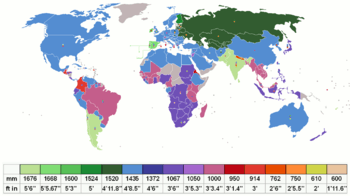900 mm gauge railways
Track gauge
| By transport mode |
Tram · Rapid transit
Miniature · Scale model |
| By size (list) |
 |
|
|
Minimum |
| |
Fifteen inch |
381 mm |
(15 in) |
|
|
Narrow |
| |
600 mm,
Two foot |
597 mm
600 mm
603 mm
610 mm |
(1 ft 11 1⁄2 in)
(1 ft 11 5⁄8 in)
(1 ft 11 3⁄4 in)
(2 ft) |
| |
750 mm,
Bosnian,
Two foot six inch,
800 mm |
750 mm
760 mm
762 mm
800 mm |
(2 ft 5 1⁄2 in)
(2 ft 5 15⁄16 in)
(2 ft 6 in)
(2 ft 7 1⁄2 in) |
| |
Swedish three foot,
900 mm,
Three foot |
891 mm
900 mm
914 mm |
(2 ft 11 3⁄32 in)
(2 ft 11 7⁄16)
(3 ft) |
| |
Metre |
1,000 mm |
(3 ft 3 3⁄8 in) |
| |
Three foot six inch,
Cape, CAP, Kyōki |
1,067 mm |
(3 ft 6 in) |
| |
Four foot six inch |
1,372 mm |
(4 ft 6 in) |
|
| |
Standard |
1,435 mm |
(4 ft 8 1⁄2 in) |
|
|
Broad |
| |
Russian,
Five foot |
1,520 mm
1,524 mm |
(4 ft 11 27⁄32 in)
(5 ft) |
| |
Irish |
1,600 mm |
(5 ft 3 in) |
| |
Iberian |
1,668 mm |
(5 ft 5 21⁄32 in) |
| |
Indian |
1,676 mm |
(5 ft 6 in) |
| |
Six foot |
1,829 mm |
(6 ft) |
| |
Brunel |
2,140 mm |
(7 ft 1⁄4 in) |
|
| Change of gauge |
Break-of-gauge · Dual gauge ·
Conversion (list) · Bogie exchange · Variable gauge |
| By location |
| North America · South America · Europe · Australia |
 |
| |
900 mm (2 ft 11 7⁄16 in) narrow gauge railways are generally found in Europe. This gauge is mostly used for light urban rail networks, industrial and agricultural railways.
Installations
| Country/territory |
Railway |
|---|
| Australia |
|
| Austria |
|
| Estonia |
- Vaivara-Viivikonna mine railway (converted to standard gauge, then converted to 1,520 mm (4 ft 11 27⁄32 in) Russian gauge)
|
| Finland |
|
| Georgia |
|
| Germany |
|
| Guernsey |
|
| Iceland |
|
| Indonesia |
- Used by Rendeng sugar mill for sugar cane transport
|
| Ireland |
|
| Norway |
- Used by the Germans up to 1945, called Feldbahn (field railway), for industrial plants or other temporary uses. In Norway during the WW2 the Germans built a 15 km railway between the harbour at Årdalstangen and the industrial plant of Øvre Årda. It closed in 1959, by then used only at the iron works. One steam locomotive was lost into the sea, but was found by divers around 1990 and is restored and exhibited at Aardalstangen.
|
| Poland |
- Cracow tramways (converted to standard gauge)
|
| Portugal |
- Lisbon tramways (from 1901) and their preceding mule cars (regauged in 1888-1894 from 1,435 mm (4 ft 8 1⁄2 in))
- Braga tramways (1914-1963)
- Linha do Porto à Póvoa e Famalicão and its branch lines (Leixões and São Gens), built in 1871-1893 and regauged to 1,000 mm (3 ft 3 3⁄8 in) in 1930
|
In Sweden there has been an extensive network of railways with 891 mm (2 ft 11 3⁄32 in) gauge, Swedish three foot gauge railways. Some of them remain. This is so close to 900 mm (2 ft 11 7⁄16 in) that they are more or less compatible, and some sales of rolling stock between the gauges have taken place.
See also
|
|---|
|
| Minimum gauge | |
|---|
|
| Narrow gauge | |
|---|
|
| Standard gauge | |
|---|
|
| Broad gauge |
- 1445 mm gauge 1,445 mm (4 ft 8 7⁄8 in)
- 4 ft 10 7⁄8 in (1,495 mm), Toronto
- 5 ft/1,524 mm and 1520 mm, Russian gauge
- 5 ft 3 in (1,600 mm), Irish gauge
- 1,668 mm (5 ft 5 21⁄32 in), Iberian gauge
- 5 ft 6 in (1,676 mm), Indian gauge
- 7 ft 1⁄4 in (2,140 mm), Brunel gauge
- 3,000 mm (9 ft 10 1⁄8 in), Breitspurbahn
- List of broad tram track gauges
|
|---|
|
| Gauge differences | |
|---|
|
| Categories |
- by country
- by imperial units
- by metric units
- by name
- lists of track gauges
|
|---|

